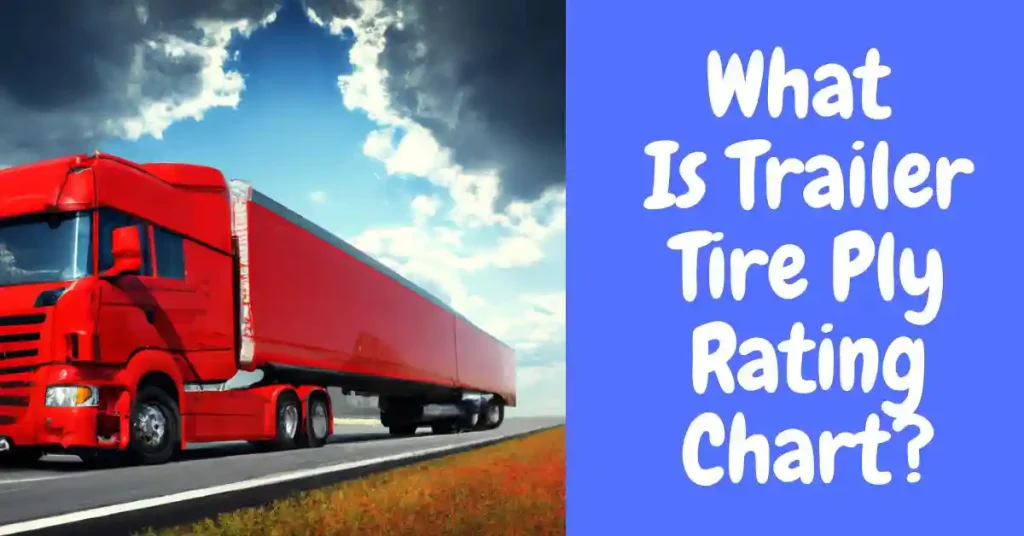Trailer tire ply rating is an important consideration when selecting tires for a trailer. The ply rating of a tire is an indicator of its load capacity, durability, and resistance to punctures.
So, Discuss here about Trailer Tire Ply Rating Chart for vast knowledge. In the past, the ply rating referred to the actual number of layers of cotton fabric used in the tire’s construction.
For example, a 4-ply tire had four layers of cotton fabric. As technology evolved, manufacturers started using stronger materials like steel and synthetic fibers, allowing them to build tires with fewer layers but higher strength and durability.
Today, ply rating is more of a strength equivalent. While modern tires may not have the exact number of layers indicated by their ply rating, the rating serves as an indication of what their strength would be if they were built using the old cotton fabric methodology.
The following is a general guide that lists typical applications for each ply rating, but it’s important to note that the actual carrying capacity can vary depending on the specific tire and manufacturer.
Trailer Tire Ply Rating Chart (general) – for your knowledge

| Load Range | Ply Rating | Typical Applications |
|---|---|---|
| B | 4 | Light-duty trailers, Passenger vehicles |
| C | 6 | Light to medium-duty trailers, some light truck tires |
| D | 8 | Medium to heavy-duty trailers |
| E | 10 | Heavy-duty trailers, Trucks, some RVs |
| F | 12 | Heavier duty trailers and trucks |
| G | 14 | Very heavy trailers, commercial trucks |
| H | 16 | Extremely heavy-duty applications, commercial trucks |
| J | 18 | Specialized, commercial heavy haulers |
| L | 20 | Specialty tires for extremely heavy loads |
a more detailed breakdown of each load range:
Load Range B (Ply Rating 4): This is typically the lowest ply rating you’ll see for trailer tires. These tires are generally used for light-duty trailers and passenger vehicles. Examples might include small utility trailers, boat trailers, or pop-up campers.
Load Range C (Ply Rating 6): These tires are suitable for light to medium-duty trailers and some light truck tires. You might find these on larger utility trailers, medium-sized boat trailers, or smaller travel trailers.
Load Range D (Ply Rating 8): This rating is suitable for medium to heavy-duty trailers. These are often used on larger travel trailers, car haulers, or small fifth-wheel trailers.
Load Range E (Ply Rating 10): These tires are intended for heavy-duty trailers, trucks, and some recreational vehicles (RVs). They are often used on larger fifth-wheel trailers, horse trailers, and larger trucks.
Load Range F (Ply Rating 12): These are for even heavier duty trailers and trucks. They are often found on commercial trailers or larger RVs.
Load Range G (Ply Rating 14): These tires are intended for very heavy trailers and commercial trucks. They are often used on large commercial trailers, buses, and heavy-duty trucks.
Load Range H (Ply Rating 16): These are for extremely heavy-duty applications and commercial trucks. They can be found on heavy-duty commercial vehicles and trailers, as well as some specialized equipment.
Load Range J (Ply Rating 18): These are specialized tires for commercial heavy haulers. They are typically used on very large trailers, commercial trucks, and other heavy-duty equipment.
Load Range L (Ply Rating 20): These are specialty tires for extremely heavy loads. They are often used for the heaviest duty applications, including some industrial and agricultural equipment.
Frequently Asked Questions of Trailer Tire Ply Rating Chart
What is a ply rating in a trailer tire?
A ply rating in a trailer tire refers to the tire’s load capacity and durability. Historically, it represented the number of layers of cotton fabric used in the tire’s construction.
However, with modern tire technology, this has shifted to represent strength equivalent, as modern tires use stronger materials like steel and synthetic fibers.
How does the ply rating affect a tire’s performance?
The ply rating affects a tire’s load capacity, durability, and resistance to punctures. A tire with a higher ply rating can generally carry a heavier load and is more resistant to punctures and wear.
Is a higher ply rating always better for my trailer?
Not necessarily. While higher ply ratings mean a tire can handle more weight, it’s essential to match the tire’s ply rating with the load requirements of your specific trailer. Using tires with an excessively high ply rating for your trailer could result in a harsher ride and may not improve performance.
Can I replace my current trailer tires with tires of a different ply rating?
Yes, but it’s crucial to ensure that the new tires can safely support the weight of your trailer and its load. It’s recommended to refer to your trailer’s owner manual or consult with a tire professional when considering tires with a different ply rating.
Where can I find the ply rating of a trailer tire?
The ply rating or load range is typically found on the tire’s sidewall. It’s usually listed as a letter (B, C, D, E, F, G, H, J, L), which corresponds to a ply rating (4, 6, 8, 10, 12, 14, 16, 18, 20 respectively).
Conclusion
Always remember that the ply rating is just one factor to consider when choosing tires. It’s also important to consider the tire’s load index, speed rating, and the specific requirements of your trailer and load. Always consult your trailer and tire manufacturer’s guidelines when selecting new tires.